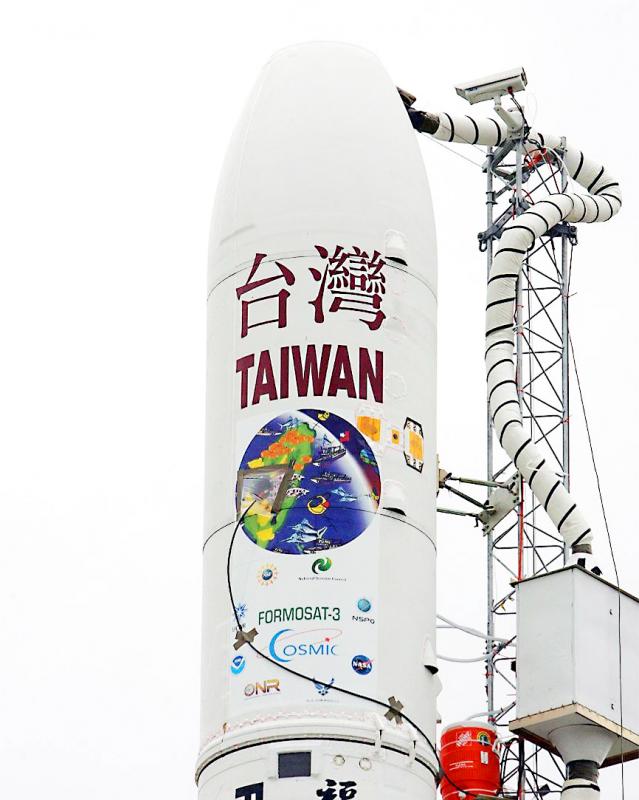The Formosat-3/COSMIC satellite constellation, a Taiwan-US collaboration, is to officially retire today, with the Formosat-7/COSMIC-2 constellation taking over its weather observation mission, the National Space Organization (NSPO) said yesterday.
The six-satellite Formosat-3 constellation was launched on April 15, 2006, atop a Minotaur rocket from Vandenberg Air Force Base in California.
Its original mission was to end after five years, but it has far outlived its expected life span, with only one satellite, the FM6, intermittently producing limited meteorological radio occultation data, said the NSPO, an agency under the National Applied Research Laboratories.

Photo courtesy of the National Applied Research Laboratories
The NSPO is to determine if FM6 — the only one that can still receive signals — can be recalled to be burned up in the atmosphere, NSPO Deputy Director-General Yu Shiann-jeng (余憲政) told the Taipei Times.
The agency has already lost communication with the other five satellites, Yu said.
The agency and the US National Oceanic and Atmospheric Administration decided to terminate the satellite’s functions, ending its data transmission and upload capabilities, the NSPO said.
Formosat-3’s accuracy and stability was recognized by the global meteorology community, with the European Centre for Medium-Range Weather Forecasts (ECMWF) in 2012 calling it the fifth-best meteorological observation system.
Despite generating a relatively small volume of data — about 2 to 3 percent of all data used in weather forecasting — Formosat-3 contributed to reducing forecast errors by 10 percent, the ECMWF said.
It assisted the US government in making emergency evacuation decisions with its accurate prediction of Hurricane Sandy’s trajectory in 2012, the NSPO said.
“As of Monday last week, there are 4,551 registered community users from 92 nations that used the data,” the NSPO said.
The constellation set an excellent lifetime record and has been mentioned in numerous papers featured in leading academic journals, such as Nature and Science, as well as publications focused on atmospheric science and engineering, it added.
The Formosat-7 constellation, which is also comprised of six satellites, was launched on June 25 last year.
Data gathered by Formosat-7 has been publicly available since March 7.
The Central Weather Bureau’s data analysis center daily releases all meteorological data gathered from the previous day, allowing research facilities to apply to research extreme or abnormal weather patterns; the formation of typhoons and their paths; and predictions and analysis for heavy rainfall, the NSPO said.
Additional reporting by Lin Chia-nan

Taiwan is stepping up plans to create self-sufficient supply chains for combat drones and increase foreign orders from the US to counter China’s numerical superiority, a defense official said on Saturday. Commenting on condition of anonymity, the official said the nation’s armed forces are in agreement with US Admiral Samuel Paparo’s assessment that Taiwan’s military must be prepared to turn the nation’s waters into a “hellscape” for the Chinese People’s Liberation Army (PLA). Paparo, the commander of the US Indo-Pacific Command, reiterated the concept during a Congressional hearing in Washington on Wednesday. He first coined the term in a security conference last

Prosecutors today declined to say who was questioned regarding alleged forgery on petitions to recall Democratic Progressive Party (DPP) legislators, after Chinese-language media earlier reported that members of the Chinese Nationalist Party (KMT) Youth League were brought in for questioning. The Ministry of Justice Investigation Bureau confirmed that two people had been questioned, but did not disclose any further information about the ongoing investigation. KMT Youth League members Lee Hsiao-liang (李孝亮) and Liu Szu-yin (劉思吟) — who are leading the effort to recall DPP caucus chief executive Rosalia Wu (吳思瑤) and Legislator Wu Pei-yi (吳沛憶) — both posted on Facebook saying: “I

Sung Chien-liang (宋建樑), who led efforts to recall Democratic Progressive Party (DPP) Legislator Lee Kun-cheng (李坤城), was released on bail of NT$80,000 today amid outcry over his decision to wear a Nazi armband to questioning the night before. Sung arrived at the New Taipei District Prosecutors’ Office for questioning in a recall petition forgery case last night wearing a red armband bearing a swastika, carrying a copy of Adolf Hitler’s Mein Kampf and giving a Nazi salute. Sung left the building at 1:15am without the armband and covering the book with his coat. Lee said today that this is a serious

A mountain blaze that broke out yesterday morning in Yangmingshan National Park was put out after five hours, following multi agency efforts involving dozens of fire trucks and helicopter water drops. The fire might have been sparked by an air quality sensor operated by the National Center for High-Performance Computing, one of the national-level laboratories under the National Applied Research Laboratories, Yangmingshan National Park Headquarters said. The Taipei City Fire Department said the fire, which broke out at about 11am yesterday near the mountainous Xiaoyoukeng (小油坑) Recreation Area was extinguished at 4:32pm. It had initially dispatched 72 personnel in four command vehicles, 16